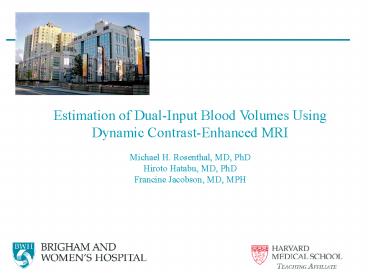Estimation of Dual-Input Blood Volumes Using Dynamic Contrast-Enhanced MRI - PowerPoint PPT Presentation
1 / 9
Title:
Estimation of Dual-Input Blood Volumes Using Dynamic Contrast-Enhanced MRI
Description:
... signal used to isolate enhancement Monte Carlo Simulation Numerical phantom Six vascular compartments Eleven mixed targets Gaussian white noise ... MRI ... – PowerPoint PPT presentation
Number of Views:93
Avg rating:3.0/5.0
Title: Estimation of Dual-Input Blood Volumes Using Dynamic Contrast-Enhanced MRI
1
Estimation of Dual-Input Blood Volumes Using
Dynamic Contrast-Enhanced MRI Michael H.
Rosenthal, MD, PhD Hiroto Hatabu, MD,
PhD Francine Jacobson, MD, MPH
2
- Traditional Perfusion Analysis
- Exponential kinetic models
- Homogeneous compartments and voxels
- Limited emphasis on dual-input vascular
supplies - Challenges
- Subvoxel characterization
- Measurement and modeling of dual inflows
- Temporal resolution
3
- Composite Voxels
- Consider tissue voxels as a mixture of reference
vascular signals - Estimate weighting factors ai using least squares
- Subtracted signal used to isolate enhancement
4
- Monte Carlo Simulation
- Numerical phantom
- Six vascular compartments
- Eleven mixed targets
- Gaussian white noise to test SNR from 0.1 to 5.0
- ROIs from 1 to 900 pixels
- Sampling from 1/s to 0.1/s
- 206,250 iterations
5
- Results
- Standard error in vessel contents 3
- SNR 0.2 and ROI 100 pixels at 0.1 Hz
- SNR 1 and ROI 25 pixels at 0.1 Hz
- Standard error in vessel contents 1
- SNR 1 and ROI 81 pixels at 0.1 Hz
6
Clinical DCE-MRI Example
7
Characterization of Pulmonary Tissues in Clinical
DCE-MRI Cases
Tissue of Interest Pulmonary Arterial Fraction Volume Systemic Arterial Fraction Volume
Pleural Mesothelioma 0.04 0.29
Normal Lung 0.11 0.02
Chronic Atelectasis 0.06 0.17
Normal Lung 0.06 0.02
8
Conclusions Viewing voxels as mixtures of
reference signals allows subvoxel estimation in a
simple numerical phantom Early anecdotal
promise in clinical applications Prospective
clinical evaluation in progress
9
This work was supported in part by RSNA Research
and Education Foundation Resident Research Grant
RR0826. Questions?































